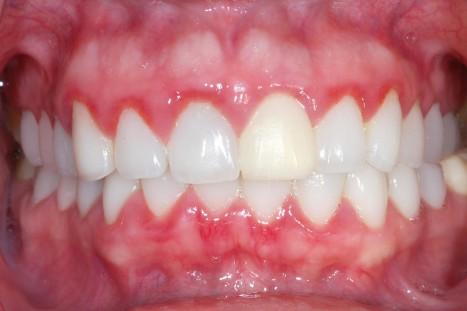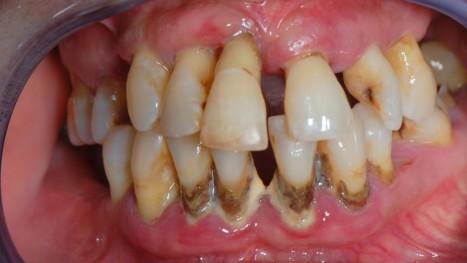What is periodontitis?
Periodontitis is a serious infection of the gums. It’s caused by bacteria that have been allowed to accumulate on your teeth and gums. As periodontitis progresses, your bones and teeth can be damaged. However, if periodontitis is treated early and proper oral hygiene is maintained, the damage can be stopped.
What are the stages of periodontitis?

Periodontitis starts as inflammation and gets worse over time.
Inflammation (gingivitis)
Periodontitis begins with inflammation in the gums known as gingivitis. One of the first signs of gingivitis is that your gums will bleed when you brush or floss your teeth.
Early periodontal disease
In the early stages of periodontitis, your gums recede, or pull away, from your teeth and small pockets form between gums and teeth. The pockets harbor harmful bacteria. You’ll likely experience bleeding during brushing and flossing as well, and possibly some bone loss.
Moderate periodontal disease
You might experience bleeding and pain around the teeth and gum recession. Your teeth will begin to lose bone support and become loose. The infection can also lead to an inflammatory response throughout your body.
Advanced periodontal disease
The gums, bones, and other tissue that support your teeth are destroyed. If you have advanced periodontitis, you might experience severe pain while chewing, severe bad breath, and a foul taste in your mouth. You’ll likely lose your teeth.
What are the symptoms of periodontitis?

The symptoms depend on the stage of disease, but generally include:
- gums that bleed when you brush your teeth or floss
- bad breath
- changes in the position of your teeth or loose teeth
- receding gums
- red, tender, or swollen gums
- buildup of plaque or tartar on your teeth
- pain when chewing
- tooth loss
- foul taste in your mouth
- inflammatory response throughout your body
Symptoms in the early stages of periodontitis are often not very noticeable. Your dentist will likely be the first to point them out.
What causes periodontitis?
Periodontitis is typically caused by poor dental hygiene. When you don’t brush your teeth and clean in hard-to-reach places in your mouth, the following happens:
- The bacteria in your mouth multiply and form a substance known as dental plaque.
- If you don’t remove the plaque by brushing, the bacteria deposit minerals within the plaque over time.
- This mineral deposit is known as tartar, which will encourage more bacterial growth toward the root of the tooth.
- Your body’s immune response to this bacterial growth leads to inflammation in your gums.
- The attachment of the gum to the root of a tooth is disrupted over time, and a periodontal pocket (gap) may form between the gum and root.
- Harmful anaerobic bacteria colonize in the pocket and multiply, releasing toxins that can damage the gums, teeth, and supporting bone structures.
Additionally, certain factors put you at a higher risk of periodontitis, including:
- smoking, which is one of the biggest risk factors for periodontitis
- type 2 diabetes
- obesity
- hormonal changes in women (such as when menstruation, pregnancy, or menopause occurs), which can make the gums more sensitive
- conditions that impact your immune system, like HIV or leukemia
- medications that reduce the flow of saliva in your mouth
- genetics
- poor nutrition, including a deficiency in vitamin C
How is periodontitis diagnosed?
Your dentist will be able to detect signs of periodontitis at an early stage during a routine dental examination. They can monitor your periodontal status over time to make sure it doesn’t get any worse.
Your dentist may use a tiny ruler called a probe to measure any pockets on your gums. This test is usually painless. If plaque, tartar, or both are found on your teeth, your dentist will remove these substances as part of a professional cleaning. They may also take dental X-rays or refer you to a periodontist, an expert in the diagnosis and treatment of gum disease, for further testing and treatment.
What are the complications of periodontitis?
If not treated for periodontitis, the supporting structures of your teeth, including the bones of your jaw, can be destroyed. Your teeth loosen and might fall out or require extraction. Other complications of periodontitis include:
- painful abscesses
- migration of your teeth, which may interfere with eating
- receding gums and exposure of the roots of your teeth
- increased risk of complications during pregnancy, including low birth weight and preeclampsia
- increased risk of heart disease, respiratory disease, and diabetes
How is periodontitis treated?
- Oral hygiene practices
Your dentist will give you advice on how to use tooth brushes and dental floss properly, and may recommend other oral hygiene products like a water pick or mouthwash. - Professional cleanings
Your dentist will remove plaque buildup and tartar from your teeth and their roots, and then polish your teeth and treat them with fluoride. A deep-cleaning method called scaling and root planing will help scrape off tartar and also remove any rough spots on the tooth root where bacteria tend to gather. - Antibiotics
In some cases, your dentist will prescribe antibiotics to help with persistent gum infections that haven’t responded to cleanings. The antibiotic might be in the form of a mouthwash, gel, or an oral tablet or capsule. - Follow-up appointments
If periodontal pockets are still present, they may recommend other treatment options, like surgery. - Surgery
If inflammation persists in sites that are inaccessible to brushing and flossing, your dentist may recommend a surgical procedure called flap surgery to clean deposits under your gums.








